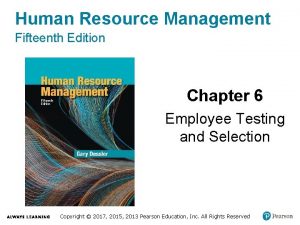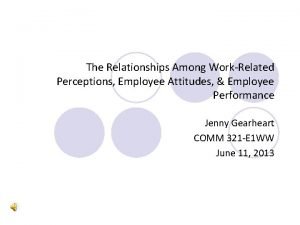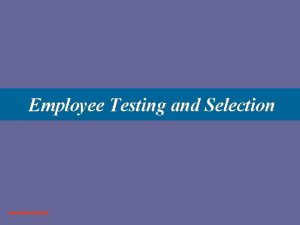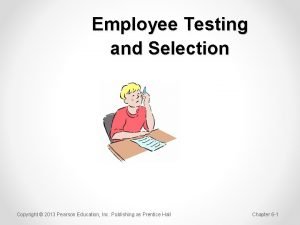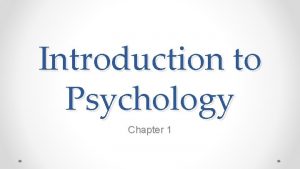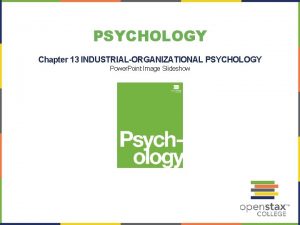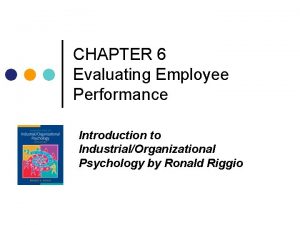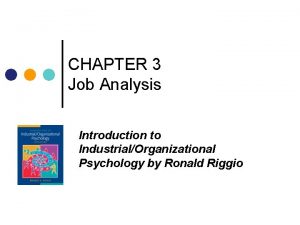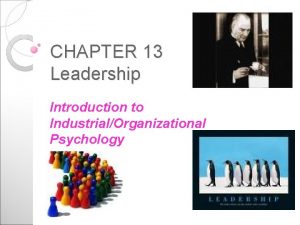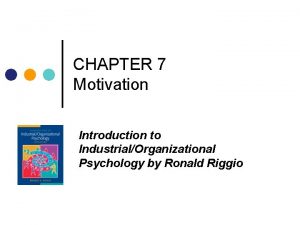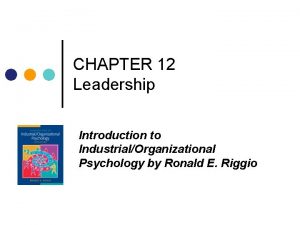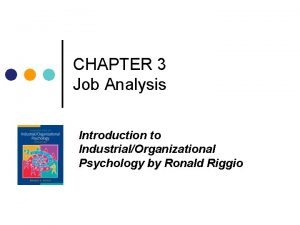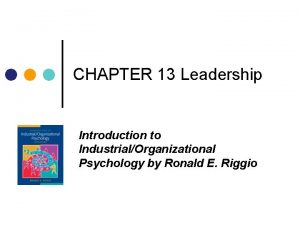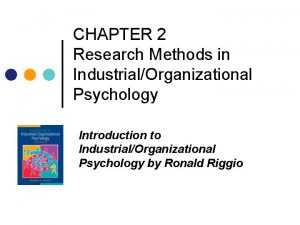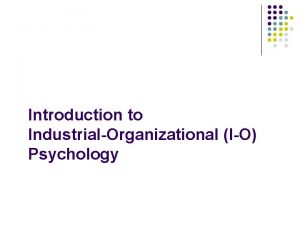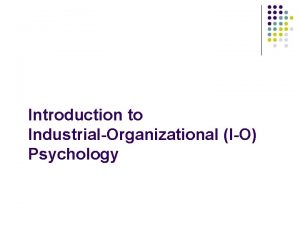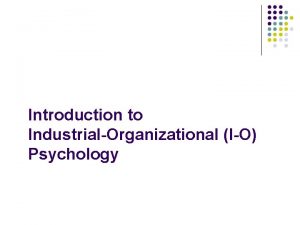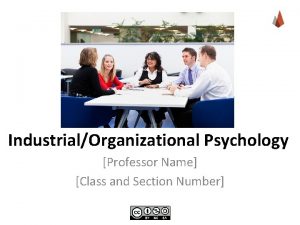CHAPTER 4 Employee Selection Introduction to IndustrialOrganizational Psychology





















- Slides: 21

CHAPTER 4 Employee Selection Introduction to Industrial/Organizational Psychology by Ronald Riggio

A Model for Employee Selection ¢ Criteria are measures of job success typically related to performance; for example, a criteria for successful basketball performance would be the number of baskets made. ¢ Predictors are variables about applicants that are related to the criteria; predictors for successful basketball performance could be experience and physical height.


Employee Recruitment ¢ Employee recruitment is the process of attracting potential workers to apply for jobs. ¢ There a variety of employee recruitment methods, such as: advertisements, college recruitment programs, employment agencies, and employee referrals.

Employee Recruitment ¢ An important element of the recruitment process is to present applicants with an accurate picture of the job through the use of Realistic Job Previews (RJPs). ¢ These are accurate descriptions of a daily tasks, duties, and responsibilities. ¢ RJPs help increase satisfaction and decrease turnover of new employees.

Employee Screening Employee screening is the process of reviewing information about job applicants to select individuals for jobs. ¢ Data sources such as resumes, job applications, letters of recommendation, employment tests, and hiring interviews can be used in screening and selecting candidates. ¢

Employee Screening ¢ Basic background information can be translated into numerical values to compare the qualifications of applicants through the use of weighted application forms or biographical information blanks (BIBs).

Employee Screening ¢ ¢ ¢ Employee screening also involves references and letters of recommendation. Such sources can provide information about: l Employment and educational history. l Evaluations of the applicant’s character. l Evaluations of the applicant’s job performance. l The recommender’s willingness to rehire the applicant. The use of these methods is on the decline because they tend to be overly positive and are often uninformative.

Employee Screening ¢ ¢ The second step in screening is employee testing, which typically uses standardized instruments to measure characteristics that are predictive of job performance. Any screening test or method must demonstrate that it is a reliable and valid predictor of job performance. l A measurement instrument is reliable if it repeatedly gives the same or similar results when applied repeatedly to the same quantity. l A measurement instrument that is valid is accurately measuring what it purports to measure.

Employee Screening ¢ ¢ Three methods for establishing reliability are test‑retest reliability, parallel forms, and internal consistency. Two forms of validity that are most important for development and use of screening tests are: l Content validity, or whether the test content adequately measures the knowledge, skills and abilities required by the job. l Criterion‑related validity, or the relationship between screening test scores and some criterion of job success.

Employee Screening ¢ ¢ ¢ Employee screening tests vary greatly in format and in characteristics they measure. Categories of such tests include: l Cognitive ability tests. l Mechanical ability tests. l Motor and sensory ability tests. l Job skills and knowledge tests. l Personality tests. l Miscellaneous instruments such as polygraphs. Standardized tests are often used in combination in test batteries to help select the best qualified candidates.



Employee Screening An important issue regarding the effectiveness of employee screening tests is validity generalization, or a test's ability to predict job performance in settings different from the one in which it was validated. ¢ Another concern is test utility, an estimate of the dollars gained in increased productivity and efficiency because of the use of screening tests. ¢

Employee Screening Faking is trying to beat an employment test by distorting responses. ¢ Assessment centers use the test battery approach to offer a detailed, structured assessment of applicants' employment potential most often for high‑level managerial positions. ¢


Employee Screening ¢ ¢ ¢ Employment screening for most jobs includes at least one hiring interview, which is a measurement tool just like any other screening device. Unfortunately, research indicates that hiring interviews (as they are typically used) generally have low levels of reliability and validity. One of the greatest sources of problems with hiring interviews stems from interviewer biases.

Employee Selection and Placement ¢ Statistical models of decision-making include: The multiple regression model, an approach that allows predictors to be combined statistically. l The multiple cutoff strategy, a method of setting minimum cutoff scores for each predictor. l The multiple hurdle approach, a stringent method that uses an ordered sequence of screening devices. l


Employee Selection and Placement ¢ ¢ ¢ Regardless of the screening and selection procedures used, an overriding concern in all personnel decisions is to protect against discrimination in employment. The federal Equal Employment Opportunity Commission (EEOC) has established guidelines to ensure against discrimination against ethnic minorities and other protected groups. To take preventive steps to avoid employment discrimination, many organizations have adopted affirmative action plans to ensure jobs are made available to members of protected groups.

 Chapter 6 employee testing and selection ppt
Chapter 6 employee testing and selection ppt Employee attitudes and employee performance
Employee attitudes and employee performance Employee testing and selection
Employee testing and selection Employee testing and selection summary
Employee testing and selection summary 2013 pearson education inc. answers
2013 pearson education inc. answers Employee selection
Employee selection Employee selection
Employee selection Employee testing and selection
Employee testing and selection Groupthink vs. group polarization
Groupthink vs. group polarization Balancing selection vs stabilizing selection
Balancing selection vs stabilizing selection Similarities
Similarities K selection r selection
K selection r selection Natural selection vs artificial selection
Natural selection vs artificial selection Artificial selection vs natural selection
Artificial selection vs natural selection Directional selection
Directional selection K selection r selection
K selection r selection Natural selection vs artificial selection
Natural selection vs artificial selection Two way selection and multiway selection
Two way selection and multiway selection Multiway selection
Multiway selection Mass selection
Mass selection Introduction to psychology chapter 1
Introduction to psychology chapter 1 Introduction to psychology chapter 1
Introduction to psychology chapter 1
